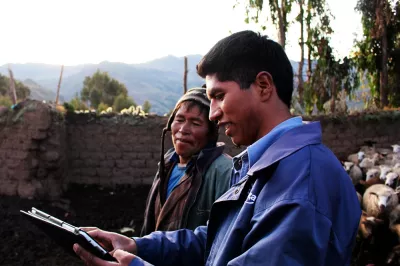COVID-19 and Microfinance: What’s Next for Equity Investors?
When we think about the past 18 months and the challenges microfinance providers have faced in the midst of the COVID-19 crisis, one of the highest priorities has been access to funding. Having sufficient liquidity to meet obligations and continue operations has been key to survival. As described in CGAP’s recent publication, "Microfinance Solvency and COVID-19: A Call for Coordination," debt investors, particularly microfinance investment vehicles (MIVs), responded quickly and effectively to provide breathing room to microfinance providers through a coordinated effort. This effort included a memorandum of understanding (MOU) outlining debt investors’ approach and desire to work through handshake deals rather than formal legal channels. Members of the Financial Inclusion Equity Council (FIEC), an association of leading equity investors, also expressed their commitment to support their investee institutions through the crisis. Now, as financial service providers focus on recovery and growth, equity capital in addition to debt, is required.

With moratoria and other regulatory relief measures in place for extended periods, investors have had difficulty knowing with any degree of certainty the quality of their investees’ portfolios, probable losses and financial strength. The unpredictable nature of the pandemic, with its new waves and lockdowns, has magnified the sense of uncertainty about when and how recovery will occur. Lacking confidence in the trajectory of the recovery, equity investors predictably are staying on the sidelines. In addition, uncertainty about the duration of the very critical easing of regulatory requirements, such as provisioning, write-offs and levels of capital adequacy, has created what one investor calls a state of “flexible murkiness” and begs the question: Will there be a time of regulatory reckoning?
CGAP’s brief raises the concern that smaller (Tier II and III) microfinance providers have suffered more from the impact of the pandemic and may face potential solvency risks in the near future that require infusions of capital and other life-saving measures, such as consolidation. That is not to say that larger (Tier I) institutions have not suffered losses. But generally, they were better capitalized with healthier loan portfolios pre-pandemic. It is still early days, but a common observation we hear from equity investors is that the financial institutions that currently are suffering the most are the ones that were not doing well before the pandemic.
Can we expect equity investors to step up to the plate and provide additional capital? There is no simple answer. Equity investors operate under different legal structures from holding companies to investment funds. A fund may be closed-end, which means it issues a specific number of shares and may have a limited life span, normally 7-10 years. In this case, an MIV may not be able to provide additional capital as part of a recapitalization package because the fund is fully disbursed or approaching liquidation stage. Open-ended funds do not face this constraint but must manage their commitments with respect to the timing of investor inflows and redemptions. Injecting capital into a distressed financial institution requires intense negotiations with all shareholders, including, in many cases, the founder. How will the burden be shared if the shareholders can’t come to an agreement or are not in a position to provide more capital?
The global nature of the COVID-19 crisis, unlike anything we have seen before, has strained the ability of investors to respond to the needs of every troubled microfinance provider. MIVs must decide how to allocate their limited supplemental capital, which requires taking a hard look at their portfolio companies, which they are doing now. Equity investors face a difficult choice of deciding whether to recapitalize a weak institution that may not return to profitability — and dividend payments — in the near term or provide funds to catalyze the post-pandemic growth of a company with a healthier portfolio.
Will we see consolidation of Tier II and III microfinance providers coming out of the COVID-19 crisis? Historically, mergers and acquisitions in microfinance have been few and far between due in great part to the difficulty of aligning the interests of all stakeholders. This likely is not going to change. One view expressed by several equity investors is that consolidation will take the form of an asset (portfolio) sale rather than a merger or acquisition, especially with the rapid growth of digital financial services and a move away from brick-and-mortar models. By purchasing the portfolio (generally only the performing portfolio), investors assume only designated assets and liabilities, which enables them to avoid unwanted, unforeseen or undisclosed assets and liabilities. In addition, they generally can avoid the complex and often onerous labor laws in terms of employee redundancy that arise in a merger or acquisition. They do, however, face the challenge of pricing assets of variable quality and liquidity, and recognize that an asset sale can be disruptive for clients if not properly executed. Given the lack of clarity regarding portfolio quality, related due diligence and legal costs, potential buyers are few at present.
Despite these challenges, equity investors are committed to supporting their investees and getting back to their pipeline of potential investments. To do so, they are using quasi-equity instruments such as convertible debt and, in some cases, moving forward with new investments utilizing deferred pricing agreements that adjust for future losses. But the equity investors can’t do it alone. The commitment is there, but the willingness and ability to act depends, in part, on the actions of other ecosystem players such as regulators, development finance institutions and donors. Timing is everything and likely will determine who survives.
Deborah Drake is VP, Investor Engagement and Research at the Center for Financial Inclusion (CFI). She also directs the Financial Inclusion Equity Council (FIEC). This post is part of the CGAP blog series, "Microfinance Solvency and COVID-19," which looks at key issues related to microfinance providers' solvency amid COVID-19 and explores ways forward for the sector.




Add new comment